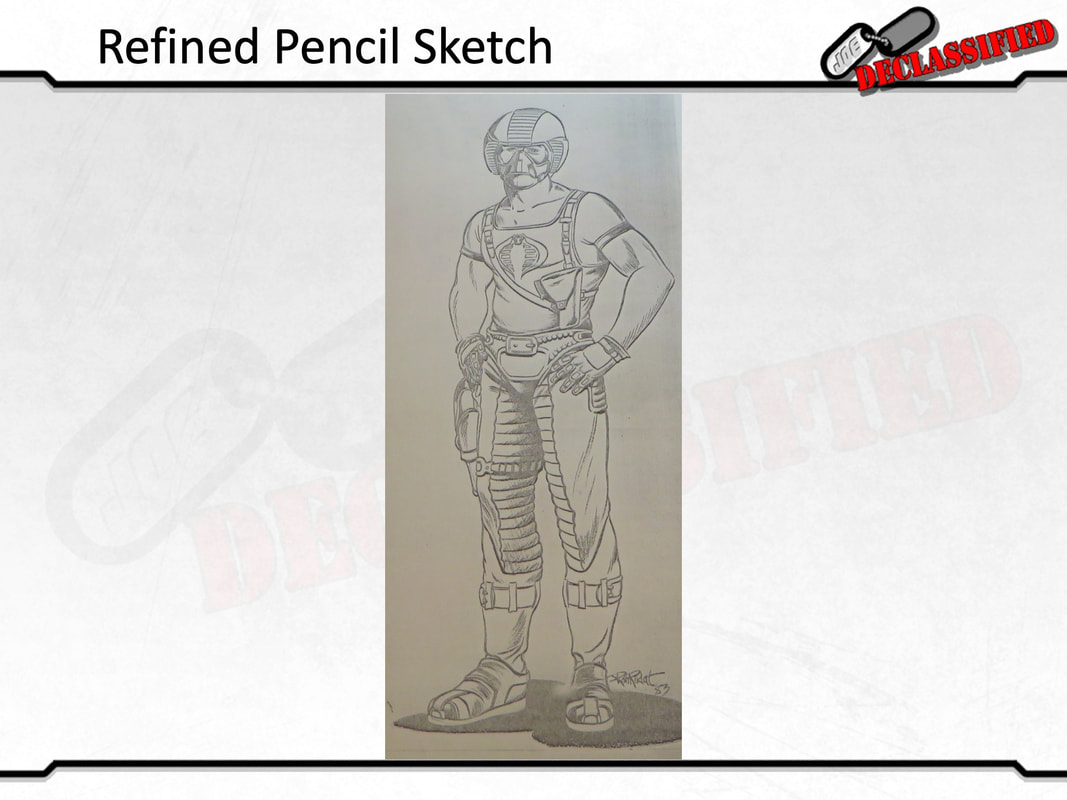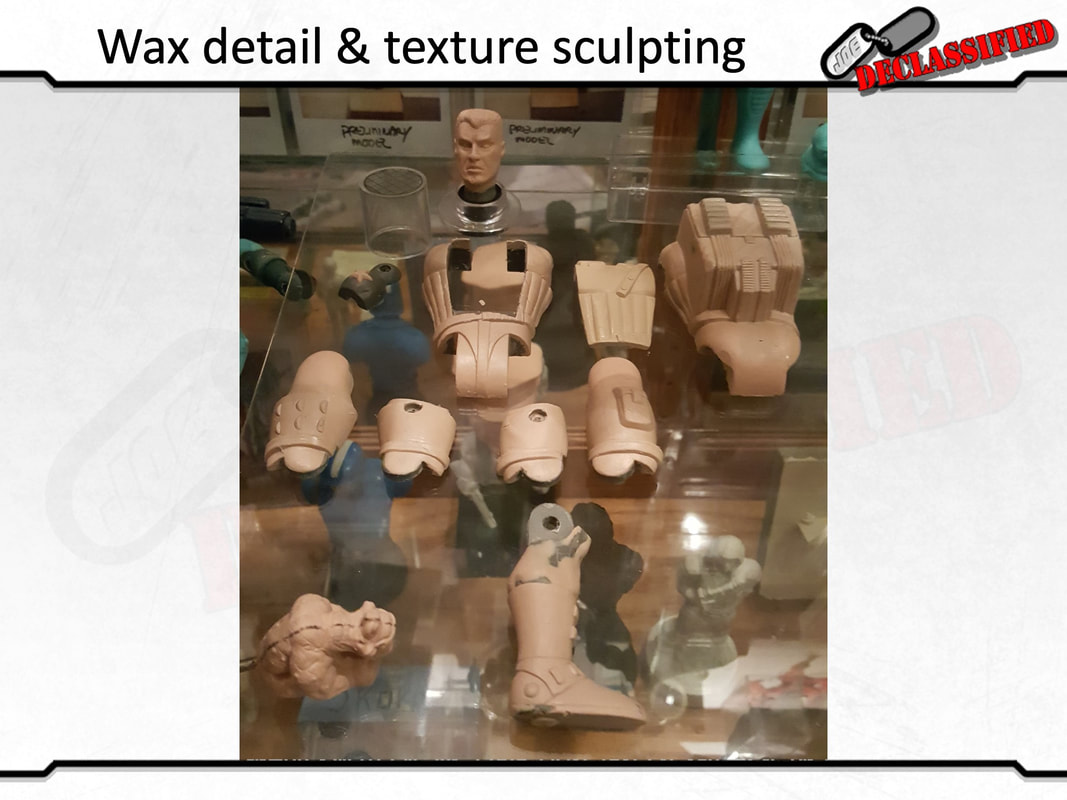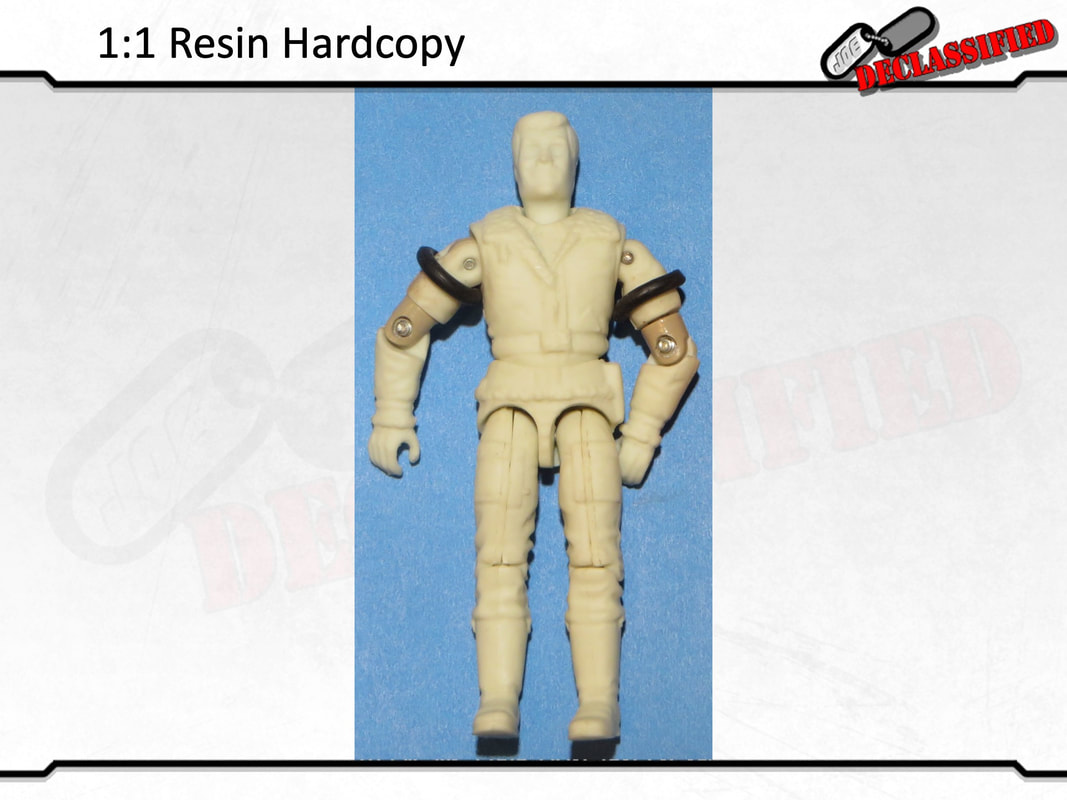G.I.Joe has been around since the 1964. This page will focus solely on the A Real American Hero era, which spanned from 1982-1994. The production process to create a New Sculpt Era figure (2002 -2008) and a Digital Era figure (2014 to present) will be presented on future pages.
This page was written by Chris “Topson” Murray and Pat “Notpicard” Stewart, and edited by R. Carson Mataxis. Information contained within was gleaned from an interview by Mark Bellomo with Ron Rudat, an article by Shane Turgeon for Joe Intel, personal interviews with Ron Rudat, Kirk Bozigian, and Kurt Groen, and personal research of Hasbro documents over the last 20+ years.
All photos and scans are used with permission and ©2012-2024 3DJoes. All Rights Reserved. No usage is permitted without written permission.
This page was written by Chris “Topson” Murray and Pat “Notpicard” Stewart, and edited by R. Carson Mataxis. Information contained within was gleaned from an interview by Mark Bellomo with Ron Rudat, an article by Shane Turgeon for Joe Intel, personal interviews with Ron Rudat, Kirk Bozigian, and Kurt Groen, and personal research of Hasbro documents over the last 20+ years.
All photos and scans are used with permission and ©2012-2024 3DJoes. All Rights Reserved. No usage is permitted without written permission.
From idea generation to factory samples
The creation of a G.I.Joe: A Real American Hero action figure, from selecting an idea to receiving factory samples of the finished figure, took an average of 41 weeks. After that initial preproduction period, factories would begin mass producing the figure, and shipping them to the USA for distribution at retail outlets. For example, preproduction of the G.I.Joe: A Real American Hero action figures released in 1987 began back in early October, 1985.
The preproduction process in 26 steps
NOTE: The accordion menu below will expand and contract each of the 26 preproduction steps. Simply tap the step you'd like to expand.
On a mobile device? Swipe up or down using the column to the right to scroll.
On a mobile device? Swipe up or down using the column to the right to scroll.
|
1. Idea generation
The formal preproduction process began with a team meeting to brainstorm / discuss ideas for the next year’s action figures. This meeting would include the brand manager, VP of Boys Toys, and the R&D product designer(s). Together, they would toss around ideas for figure concepts and weapon specialties. Some figures were the sole idea of one designer, and that designer would present it to the team, while other figures were the product of group discussion. By the end of this meeting, designers would be assigned concepts to explore visually.
Below you see Kurt Groen... ideating. 2. Concept art (rough pencil sketch art)
Designers such as Ron Rudat were assigned visual development of the action figure concepts approved in the idea generation meeting. In most cases, the designer would sketch four to six different takes on each character. Once these sketches were complete, the team would review. The designer would present these sketches, and a sketch, or in most cases multiple aspects of the various sketches would be selected for inclusion in the final look of that character.
Below you see four rough pencil sketches created by Ron Rudat that explored possible designs for the figure that would become 1984 Copperhead: Water Moccasin Pilot. Several elements are marked with a red pen, which indicated they should be carried forward into the refined concept art. 3. Refined concept art
After the concept team review meeting, the designer would draft a new, more polished drawing which incorporated their feedback. In some cases, designers would incorporate the likeness of their co-workers, friends, family, and celebrities when creating the final look of a character.
Below you see a refined pencil sketch created by Ron Rudat in 1983 for the figure that would become 1984 Copperhead: Water Moccasin Pilot. 4. Color Study
With approval of the refined concept art, it was time to begin exploring color options. The designer would make a stack of black and white copies of the refined concept art and then add color. This was done by hand, and the designer chose the medium. Popular mediums included pen, markers, or color pencils. Many different color palettes would be created.
At this point the design team would review color studies for several proposed characters, determining what they liked best for each individual character, but also keeping an eye on what worked best for the line as a whole. Oftentimes they would decide to share color palettes between characters to create visual cohesion for that years releases, and to cut costs on paint for that year. Below you see four color studies created by Ron Rudat for the figure that would become 1984 Copperhead: Water Moccasin Pilot. 5. In-house color presentation art
In-house presentation art was typically created by Hasbro's designers. These pieces were created to help present the character to management for final review. Typically, this presentation art would be presented with a brief bio of the character and a mini sales pitch would be done. Kirk Bozigian recalled how they would act out a commercial and talk in the characters voice. The thinking was, if they could sell the idea through to management, then they could sell it to children.
Below you see presentation art created by Kurt Groen for the figure that would become 1992 Flak-Viper: Cobra Anti-Aircraft Trooper. 6. Outsourced color presentation art
Outsourced presentation art was primarily used to promote each new figure with toy buyers. Hasbro's sales and marketing team would travel to Toys”R”Us, Sears, JCPenney, and more to make the same sales pitch they performed for Hasbro's upper management. This time around they were equipped with more refined presentation art. Artists like George Woodbridge and Dave Dorman would be paid thousands of dollars to create this art.
While outsourced presentation art pertains more to sales and marketing than development, it clearly belongs as a step in the preproduction process. Reason being, if the figure would not sell to the large toy buyers, it would not be completed. Below you see presentation art created by Dave Dorman for the figure that would become 1989 Aero-Viper: Condor Z25 Pilot. 7. Figure SculptURE Sheet, 4-view, or 4-way input drawing
Once Hasbro's senior management signed off on the figure design, the designer would get back to work creating a figure sculpture sheet. This in-house engineering sheet showed all the details of the figure from all four sides. Figures were drawn at a 2:1 scale, or ~7.5" tall, which allowed for sharper details than if they were drawn at a 1:1 scale, or 3.75". These figure sculpture sheet served as a 1:1 reference for figure sculptors, who would also work at a 2:1 scale.
These sheets were the first literal representation of what the toy should look like. Before this point, artistic license was taken with poses and expressions - figures were drawn as real people. These sculpture sheets showed the joints, screw holes, and all of the details that were planned to be on the toy. Below you see a figure sculpture sheet created by Mark Pennington on March 15th, 1986 for the figure that would become 1987 Fast Draw: Mobile Missile Specialist. 8. FIGURE SOURCE SHEET, OR Color chart
The figure source sheet shows the official color of the plastics to be poured for each part (see the color column), as well as the paint applications to be added to each figure (see the spray 1 - spray 4 columns). Color pallets were year and collection specific. To create cohesion in each year's lineup, or for each sub-group, there would be a limited number of colors used.
Below you see a figure source sheet created by Mark Pennington on March 26th, 1986 for the figure that would become 1987 Fast Draw: Mobile Missile Specialist. 9. 2-up bucK
Hasbro sculpted G.I.Joe: A Real American Hero figures at twice the size of the final product. Hasbro used this 2:1 ratio from 1982-1994 to allow the sculptor to create a higher level of detail than could be attained when working at a 1:1 ratio. These "2-Up" sculpts were then pantographed down to the appropriate size when cutting the molds.
Seen below is a 2-Up Buck like those used in the creation of G.I. Joe: A Real American Hero action figures. This buck was created by Hasbro and served as a guide; indicating the minimum necessary density for strength and providing a solid base for consistent mechanical functions. This buck preserved the necessary room within the toy for the placement of the o-ring and other internal components. These bucks were distributed to freelance sculptors along with copies of the presentation art and the figure sculpt sheet. Sculptors would apply the sculpting media of their choice to this buck to bring the new figure to life, all while ensuring the newly sculpted figure would have the same dimensions and articulation as the rest of the toy line. Sculptors were not allowed to dig into the buck. 10. 2-up sculpt
Figure sculpts were made using the artists' medium of choice. Some used 2-part epoxy, while others used wax or clay. Hasbro created many different toy lines and their internal staff could not sculpt everything. So while some sculpts were created in-house, most of the G.I.Joe: A Real American Hero sculpts were created by external contract artists. See the Bill Merklein Creator Profile to view the work of one of Hasbro's most prolific contract sculptors.
Below you see the 2-Up sculpt for the figure that would become 1988 Budo: Samurai Warrior. The 2-Up buck was cast in green, and the sculpt material was added by the artist. 11. 2-up cold cast molD
12. 2-up wax
Hasbro would then place a buck piece into the mold and pour their proprietary custom formula wax around each buck piece. This wax was sturdy, but allowed designers to make changes and/or corrections to the original sculpted 2-Up. Hasbro's designers would add more wax for additional details, and/or they would use a device called a wax pen to melt additional details into the existing wax sculpt.
13. 2-up cold cast molD
14. 2-up hard copy
Hard copies were made from resin and were hand cast from the rubber molds. Multiple copies would be made for various purposes, including being used as reference when creating the steel molds, being painted as "paint masters" and being cataloged as final figure master copies.
Below you see a 2-Up resin hard copy of the unreleased Battle Corps Baroness. 15. 2-up paintmaster
16. Pantograph
The pantograph is an instrument used for the mechanical copying and scaling of three dimensional objects. Hasbro would use a pantograph to create a 1:1 copy of the 2:1 hard copy. The video below shows a pantograph in action starting at 0:53.
17. 1:1 resin
After the 2-up was pantagraphed down and a 1:1 model was created, Hasbro would use this model to create a cold cast mold. From that mold they would create multiple resin copies of the figure. This are hard copies, but collectors often call them resin when at a 1:1 scale. Hasbro would hand paint some, and keep others as a master copy.
Below you see a 1:1 resin hard copy of the figure that would become 1992 General Flagg: G.I.Joe General. 18. 1:1 Engineering PILOT, OR test shot
Engineering pilots, or test shots, are the very first figures made from the steel molds. They can be cast in non-production colors, or in production colors. These are created to make sure the mold works correctly, and to test the plastics used to make the toy.
Below you see a test shot of the figure that would become 1985 Frostbite: Snow Cat Driver. 19. 1:1 hand painted resin
1:1 hand painted resins were typically created for marketing purposes. They would be shown in Toy Fair displays, they would be photographed for use in Toy Fair catalogs, and even they would even be photographed for the cross-sell catalogs placed into vehicle boxes when those catalogs needed to go to the printers before the finished product was ready. It is very common to see these hand painted prototypes in catalogs, and they often have different paint applications from the finished product.
Below you see three 1:1 hand painted resins, for the figures that would become 1993 Mega-Vipers: Mega-Monster Trainers (Mega Marines), 1985 Bazooka: Missile Specialist, and 1994 Nunchuk: Nunchaku Ninja v2 (Shadow Ninjas). 20. bookmolds and tampographs
At some point, the factory would have created a bookmold, which is like a paint mask that would be used to apply the paint spray applications to the toy. The figure source sheet (or color chart) and the 2-Up paint master would be used to create these book molds.
Also, any necessary tampographs would be created. Tampography, also called pad printing, combines rubber stamping and offset printing. First, artwork is etched into a metal plate known as a cliché. The artwork is sunken into the cliché's surface. Next, ink is deposited into the recessed art and excess ink is wiped away. Then a rubber pad (or tampon) is pressed against the plate to pick up the image. This pad is then pressed against the surface of the toy, leaving the image behind. Below you see the "pad print art" for the 1984 G.I.Joe figures illustrated by Ron Rudat on May 17th, 1983. Ron created 1:1 and 2:1 versions for 1985 Alpine: Mountain Trooper, 1984 Recondo: Jungle Trooper, 1984 Rip Cord: HALO Jumper, and 1985 Shipwreck: Sailor. 21. Final engineering pilots (FEPs), OR vendor sample prototypes (VSPs)
Final engineering pilots (or FEPs), also known as vendor sample prototypes (or VSPs), were samples created by the factory of the near final production toy. These FEPs were used in stress tests and for review. Quality assurance (QA) would ensure the toy met their standards, while marketing would verify that they were happy with the plastic colors, paint details and accessories.
Below you see a factory reference sample of 1992 Major Bludd: Mercenary v2 (Electronic Super Sonic Fighters). 22. Packaging color art
G.I.Joe: A Real American Hero packaging was developed by Hasbro's internal art department in partnership with Hasbro's external packaging agency, Coleman, LiPuma, Segal & Morrill, Inc. up though 1989. From 1989-1994, packaging design and moved fully in-house, while illustration was split between internal staff and external contractors. To learn more about the branding, design, and illustration of G.I.Joe: A Real American Hero packaging, see the Ed Morrill Creator Profile.
Below you see the unadorned package art for 1983 Gung-Ho: Marine and 1989 Stalker: Tundra Ranger v2. 23. Transparency, OR Kodachrome
High resolution full color transparencies were used in sales, licensing, and archiving. These transparencies would be reproduced on Kodak paper and distributed in folders to sales and marketing to show toy buyers the upcoming product. They would also be distributed to licensees that would create peripheral licensed G.I.Joe: A Real American Hero products. Finally, they were stored at Hasbro as a high resolution record of previous package artwork. In some cases, when paintings were painted over to create new versions of figures, or when paintings were lost or damaged, these transparencies remain as the only record of previous package artwork. Luckily, a 35mm Kodachrome transparency contains an equivalent of approximately 20 megapixels of data, and most of the package art transparencies are on much larger transparency film.
Below you see transparencies of the unadorned 1992 T'Jbang: Ninja Swordsman (Ninja Force) and 1992 Dice: Cobra Bo-Staff Ninja (Ninja Force) package art. Up top they are not illuminated, below they are lit by a light box. 24. Proof Card
Proof cards are early printings of action figure cardbacks. These were created and circulated for quality control purposes, to verify the cardback content was correct and to create mock-ups showing bubble placement. Some proofs were printed on slightly thinner cardstock, while others have been found on production quality cardstock. One sided proof cards have been found with a blank back, or with a blank front. Proof cards printed on both sides have also been found. All proofs are printed on a big sheet and then individually cut. Examples have been found that are die cut by a machine or hand cut by a person.
Below you see proof cards for 1991 Lampreys: Amphibious Assault Trooper v2 (Sonic Fighters) and 1990 Laser Viper: Cobra Laser Trooper. 25. Mock up packaging
Below you see mock up packaging for a 1994 Roadblock: Space Gunner v7 (Star Brigade) on a 1994 Ice Cream Soldier: Flamethrower Commando cardback using an experimental figure bubble that allowed for action poses. Next you see 1993 Leatherneck: Infantry/Training Specialist v3 on a blank cardback. Finally you see a 1993 Law: MP (Military Police) v3 test shot on an unused D.E.F. branded cardback. This figure was re-branded as part of the Battle Corps lineup.
|
Swipe here to scroll
Swipe here to scroll
Swipe here to scroll
|





























